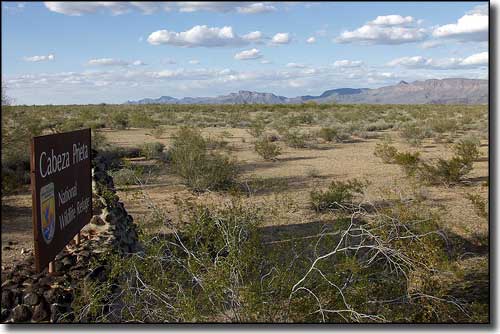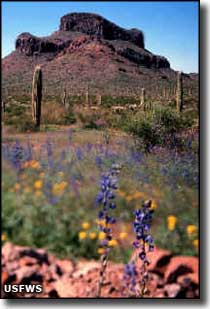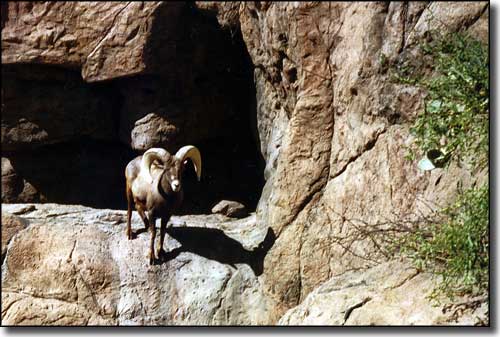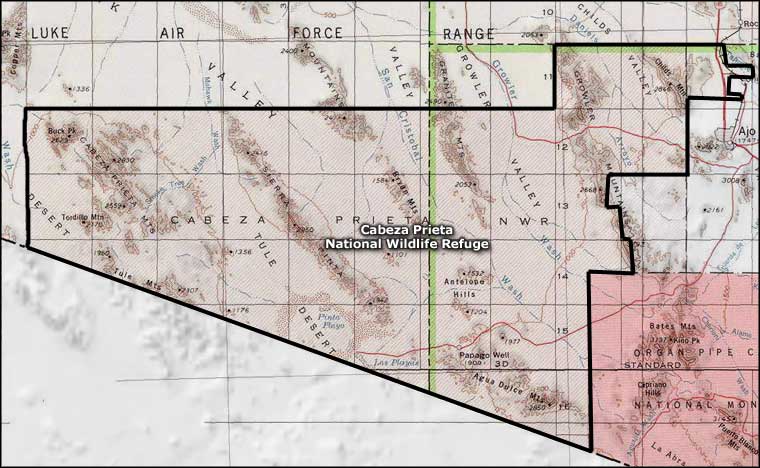
Cabeza Prieta National Wildlife Refuge

El Camino del Diablo

Cabeza Prieta Wilderness occupies almost 93% of the Cabeza Prieta National Wildlife Refuge. At 803,418 acres, Cabeza Prieta is Arizona's largest Wilderness Area (while Cabeza Prieta National Wildlife Refuge is the 3rd largest NWR in the 48 contiguous states, with some 860,010 acres). This is some of the most isolated and near-pristine desert landscape in America: broad desert valleys peppered with lava flows and sand dunes in between 7 stark, rugged mountain ranges. To enter this NWR, you need to have a permit and to sign a "Hold Harmless Agreement." The Agreement is necessary because in sections of Cabeza Prieta National Wildlife Refuge you will come across unexploded military ordnance.
Vehicular traffic is allowed only on the designated roads, although you may park up to 50' from the center of a road as long as that area has been previously used for parking (it's not hard to tell: your own vehicle tracks may still be visible in the sand and gravel here for another 100 years). While most camping is dispersed, there are some facilities at Tule Well, Christmas Pass and Papago Well. State law doesn't allow camping within 1/4 mile of a water source, so your presence doesn't interfere with the wildlife's ability to reach water.
The Cabeza Prieta National Wildlife Refuge was first established in 1939, mainly to preserve and protect desert bighorn sheep and the endangered Sonoran pronghorn in this Sonoran Desert ecosystem. Conditions here are perfect for giant saguaro, cholla, ocotillo, mesquite, creosote bush and elephant tree. There's also lots of lizards and other reptiles, many species of birds and 6 species of rattlesnake. As much as this countryside looks like barren desert to most humans, there are more than 300 wildlife species and 420 plant species that call Cabeza Prieta home. The only water available at Cabeza Prieta comes from "tinajas" (potholes in the rock that collect rainwater), some old abandoned stock tanks sometimes used by Fish & Wildlife to stock water for the wildlife, water flow in the arroyos after it rains, and one intermittent seep. The vast majority of the wildlife are burrowers that hide in the ground from the hot sun and cold days. You will also find large numbers of migratory birds passing through in those seasons (February to May, August to November).
Cabeza Prieta is bordered by Organ Pipe Cactus National Monument to the east and the Barry M. Goldwater Air Force Bombing Range to the north and west. The southern boundary of the Refuge is along 56 miles of the Mexican border. Near this border is a non-wilderness corridor containing an active 4WD trail and what is left of El Camino del Diablo, an infamous trail that used to connect Sonora with the California gold fields. El Camino del Diablo was first blazed by Father Eusebio Francisco Kino in 1699-1701. "The Devil's Highway" got its name from all the travelers who died along its route.
Before you go anyway out here you need to stop at the visitor center (1611 North 2nd Avenue in Ajo), get a permit and sign the military agreement. The visitor center is open Monday through Friday, 7:30 AM to 4:30 PM, closed on holidays. You might want to watch the introductory video about the place, too. Other than the rugged, unforgiving landscape, the temperatures that regularly rise above 105°F (and stay above 90° at night) for up to 100 days straight in the summer, the unexploded military ordnance, the multiple old mine shafts, and the variety and number of rattlesnakes, it's only the lack of water that'll be a problem for you: on days when the temperature stays below 100°, you'll only need about a gallon-and-a-half per person per day.
The western part of Cabeza Prieta tends to get about 3" of rainfall annually, while the eastern part of the NWR gets up to 9" each year. These 2 sections of the property are only about 60 miles apart but they have quite different rainfall patterns.
Some stories say that author (The Monkeywrench Gang) and famed environmentalist Edward Abbey is buried out here... among the unexploded ordinance.
To travel around out here, only the Charlie Bell Road is suitable for high-clearance 2WD vehicles. Every other road requires high-clearance 4WD. There are no facilities whatsoever out on this property (and forget your cell phone out here, although a regular GPS device will work). You'll want lots of gas and groceries, 2 gallons of water per person per day, lots of sun protection, an assortment of mechanic's hand tools and maybe a couple good spare tires. Probably the least trying time to visit Cabeza Prieta is between November and March. And if it's raining out, don't move! The roads get ridiculous within seconds and impassable within minutes.
I've come across reports of more than 200 miles of illegal phantom roads criss-crossing this National Wildlife Refuge and Wilderness carrying illegal aliens and Border Patrol agents. There's also a problem with illegal aliens lighting small cook fires that turn into raging wildfires in this extremely dry and fragile desert environment. The Wilderness Society estimates that there is about 2.5 million tons of garbage and litter, everything from discarded tin cans to abandoned vehicles, scattered through the desert arroyos and wide valleys of what was once a pristine wildlife refuge and wilderness area.

A desert bighorn sheep in its natural habitat

Cabeza Prieta National Wildlife Refuge area map
